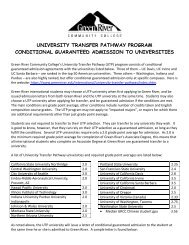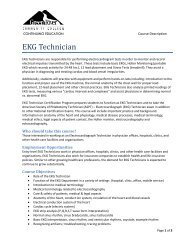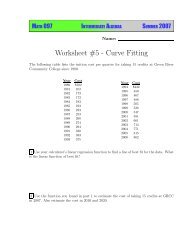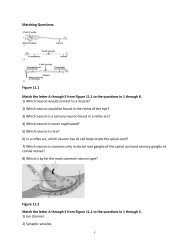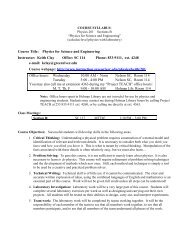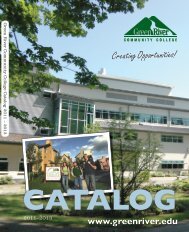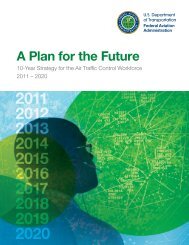Biology 213 Exam 1Practice Key - Instruction.greenriver.edu
Biology 213 Exam 1Practice Key - Instruction.greenriver.edu
Biology 213 Exam 1Practice Key - Instruction.greenriver.edu
- No tags were found...
Create successful ePaper yourself
Turn your PDF publications into a flip-book with our unique Google optimized e-Paper software.
<strong>Biology</strong> <strong>213</strong> <strong>Exam</strong> <strong>1Practice</strong> <strong>Key</strong>1. (2) Explain how plants are said to be the “lungs of the earth”?Plants are constantly taking in CO 2 from the atmosphere and giving off O 2 into theatmosphere to drive photosynthetic process, plus some can take in other airborne toxicantsand remove them from the system albeit for a short time (life of the plant).2. (3) Explain the difference in function between a cells roughER and smoothER?The roughER is a tubular shaped organelle is the usual site for protein construction forproteins that are usually moved out of the cell via vesicles, due to the ribosomes attached totheir cytoplasmic facing surface of the tube. The smoothER is the site for building variouslipid compounds and detoxifying chemicals.3. (3) Cite and explain an example of how a plant could show irritation and adaptation?Plants show the capability for irritation by a wide variety of responses, for instance failingto thrive when placed away from the sun or when not receiving enough water. Theiradaptation is growing toward a light source or removing their cuticle layer to absorb waterfrom the atmosphere directly or growing deeper root systems.4. (4) Explain two mechanisms or characteristics used to classify organisms into variousgrouping?Organisms have traditionally been categorized by their differences in their physical traits,preferred habitats, and reproductive strategies, but in more recent years science has usedchemical differences and genetic differences to group organisms into the various phyla.5. (3) Explain how phylogeny differs from taxonomy?Phylogeny is the classification system based solely on the evolutionary genetic similaritiesand differences between organisms, whereas taxonomy is the science and study ofclassification not limited in scope to just evolutionary themes.<strong>Biology</strong> &<strong>213</strong> 1 <strong>Exam</strong> 1Mr. Brumbaugh
6. (7) Match the flower terms in column A to their correct description in column B.E whorl A. the outermost whorl of a flowerG pedicel B. the structure where the flower parts are borneA calyx C. collective term for the flowers colored whorlsF sepal D. collective term covering the petals of a flowerC petal E. the arrangement of flower parts within a flowerD corolla F. typically green leaf like structures to support the flowerB receptacle G. the stalk of the flower7. (5) Match the perianth terms in column A to their correct description in column B.E regular A. petals not fusedD gamopetalous B. sepals are fusedA polypetalous C. sepals are not fusedC polysepalous D. petals are fusedB gamosepalous E. radially symmetrical8. (3) Describe (a drawing might help) the structure of the whorl called the androecium?An androecium is the third whorl of a flower and is the male component. It consists of astalk called the filament that is attached to the receptacle. On the free end of the filamentare the pollen sacs called the anthers.9. (3) Describe (a drawing might help) the structure of the whorl called the gynoecium?An gynoecium is the innermost whorl of a flower and is the female component and eachpart is called the pistil. The pistil consists of a pollen receptacle called the stigma, a long tubecalled the style which connects the stigma to the ovary, and an ovary.10. The structural difference between a hypogynous ovary and an epigynous ovary is theirA. size. B. position in the flower.C. attachment of the male parts. D. spelling.<strong>Biology</strong> &<strong>213</strong> 2<strong>Exam</strong> 1Mr. BrumbaughPage Score .
11. A leaf that bear 3 or more leave arising from the same node are calledA. acaulescent. B. alternate.C. opposite. D. whorled.12. (6) Explain three characteristics of the green algae called Charophyceans that make themthe likely "evolutionary forerunner” of the kingdom Plantae.The algae called charophyceans share with plants the same kind of cellulose organizingcomplexes in the cell membranes(organizing protein rosette), have peroxisomes for enzymestorage, have flagellated sperm (simpler plants), same chlorophyll molecules, develop a cellplate during cell division, some are multicellular, have chloroplasts, and share a greaterpercentage of genetic similarities.13. (4) Explain two characteristics of the kingdom Plantae that separate them from the greenalgae called Charophyceans.The algae called charophyceans do not practice alternation of generations, nor do theyhave an apical meristem or sporopollenin covered spores.14. (4) Explain two challenges that plants experienced to being successful in moving onto theland.Plants faced the issues of dealing with gravity, obtaining and securing water, dealing withthe loss of water, removing CO 2 from a dry environment, and anchoring to one site.15. (4) Explain two adaptations developed found in all land plants to overcome the challengesyou cited in question #14?To overcome the gravitation issues a molecule of lignin evolved to further stiffen the cellwalls which allowed plants to stand more erect. To obtain and secure water and to anchorthe plant a root system was developed. Stomata efficiency was developed to obtain CO 2 anda waxy cuticle layer covering air exposed surfaces prevented desiccation.<strong>Biology</strong> &<strong>213</strong> 3<strong>Exam</strong> 1Mr. BrumbaughPage Score .
16. (4) Explain the difference in function between xylem and phloem vascular tubes?Xylem tubes are designed to move minerals and water from the roots to higher structuresof the plant, while phloem tubes are designed to move photosynthetic products from theleaves (or other producing parts) to other parts of the plant.17. The outer layer of leaves that helps to prevent desiccation is called the ? layer.A. stomatal B. epidermisC. cuticle D. lignin18. The component of a plant cell wall that makes them extremely rigid is ? layerA. cellulose B. pectinC. hemicellulose D. lignin19. The function of plant root systems is to moveA. water. B. minerals.C. nutrients. D. both A and B.20. The first plants are thought to have moved onto the land approximatelyA. 500mya. B. 1.5mya.C. 2.5mya. C. a year ago.21. (4) Describe one structural characteristic and one habitat characteristic that would be usedto separate the bryophyte plants from other plants?Plants called bryophytes have rhizoid fibers instead of roots, have leaflets instead of leafs,have the gametophyte as the dominate form, and have separate sexed gametophytes whichproduce male or female gametes which fuse to form the diploid sporophyte that producespores to produce the male or female gametophytes. This separates them from other plants.Because they have free flagellated sperm they must live in moist habitats to ensurefertilization.22. (4) Describe one structural characteristic and one habitat characteristic that would be usedto separate the vascular seedless plants from other plants?Plants called seedless vascular plants have a rudimentary but unbranched vascularsystem, tiny gametophytes with a dominate sporophyte, need moist environment forfertilization, rudimentary roots system, and fronds for leafs.<strong>Biology</strong> &<strong>213</strong> 4<strong>Exam</strong> 1Mr. BrumbaughPage Score .
23. (4) Explain how the seedless vascular plants suffered the loss of dominance during theCarboniferous period on earth?Plants called seedless vascular plants suffered because the plant was drying out due tothe cooling of the earth, the formation of glaciers, and drying out of the earth surfaces. Asthe marshes and swamps receded the available habitats that supported this lifestyle waseliminated.24. (6) Explain three characteristics exhibited by seed plants to give them the advantage onearth beginning in the Carboniferous period?Plants called vascular seed plants replaced spores with seeds because they were moreresistant to desiccation. The gametophytes became r<strong>edu</strong>ced and retained the embryonicsporophyte for protection. R<strong>edu</strong>ced size of the male and female gametophytes and thezygote develops into an embryo packaged with a food supply. Finally pollen and pollinationpractices eliminated the need for water fertilization and favored wind and eventually insectassistance.25. (3) Describe how the ideas that attempt to explain the development of a microphyllic toeventually a megaphyllic leaf?Microphyllic leaves are thought to have evolved by the branching of the vascular channelsalong a stem, whereas the megaphyllic leaf probably evolved from further branching alongthe microphyllic initial branch.26. (3) Discuss two uses of the plants called gymnosperms by man?Gymnosperms are the large woody naked seed trees that populate our evergreen forests.We use their woody trunks for lumber to build things, we burn the bodies for heat, and someprovide medicines for our ailments (any other uses?).<strong>Biology</strong> &<strong>213</strong> 5<strong>Exam</strong> 1Mr. BrumbaughPage Score .



